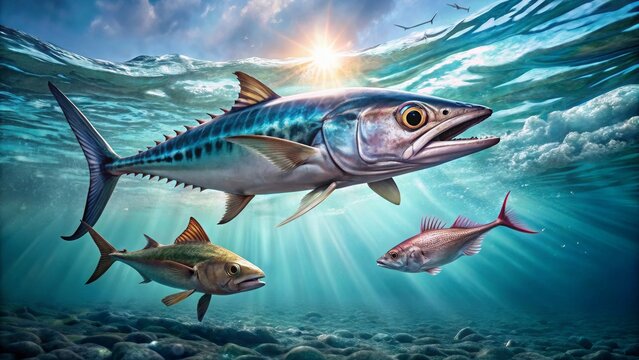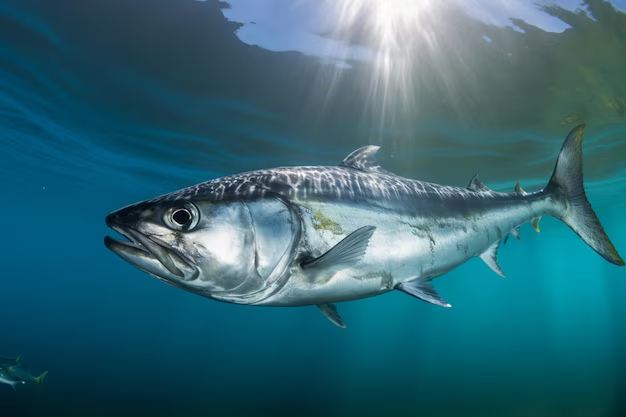Introduction: Understanding Mackerel Fish
Mackerel fish are a popular group of pelagic fish known for their speed, vibrant markings, and importance in both commercial and recreational fisheries. Scientifically known as Scomber scombrus (Atlantic mackerel), mackerels belong to the family Scombridae and are found in temperate and tropical waters worldwide. This article offers an in-depth exploration of mackerel fish, covering taxonomy, physical characteristics, habitat, behavior, conservation, and more.

Mackerel fish are scientifically classified under the following taxonomy:
Kingdom: Animalia
Phylum: Chordata
Class: Actinopterygii
Order: Perciformes
Family: Scombridae
Genus: Scomber
Species: Scomber scombrus (Atlantic mackerel), Scomber australasicus (Australian mackerel), etc.
The genus Scomber includes various species of mackerel, each varying in size and distribution. The Atlantic mackerel is the most commonly studied and commercially significant species.
The mackerel fish was first described by early ichthyologists in the 18th century. Early research focused on the mackerel’s migratory behavior, its role in marine food webs, and its potential for commercial fisheries. By the 19th century, the mackerel was recognized as an important species for both the fishing industry and culinary markets worldwide.
Mackerel fish are known for their sleek, streamlined bodies, which allow them to move quickly through the water. Key physical traits include:
Body Appearance: Mackerels have elongated, cylindrical bodies with silver underbellies and dark vertical stripes along their backs.
Body Length: Adult mackerel typically range from 30 cm to 60 cm (12 to 24 inches) in length, although larger individuals can reach up to 90 cm (35 inches).
Body Weight: Mackerels can weigh between 0.5 kg to 2 kg (1 to 4 pounds), depending on their size and species.
Lifespan: Mackerels generally live for 5 to 7 years, although some individuals in favorable conditions may live longer.
Their unique, colorful pattern helps them blend in with the water’s surface, providing camouflage from predators.
Mackerel fish are found in temperate and tropical waters across the globe. They are migratory and are often seen in large schools. The global distribution of mackerels includes:
Atlantic Mackerel (Scomber scombrus): Found predominantly in the North Atlantic, from the eastern United States to Europe.
Spanish Mackerel (Scomberomorus maculatus): Found in the Western Atlantic and the Gulf of Mexico.
Mackerel in the Indian and Pacific Oceans: Including species like the Australian mackerel (Scomber australasicus) in the Indo-Pacific region.
Mackerels typically prefer temperate waters, although some species can be found in subtropical and tropical regions. They are most often found in coastal areas, near the surface of the ocean, where they feed on small fish and plankton.

Mackerel fish are key predators in marine ecosystems, feeding on smaller fish, zooplankton, and crustaceans. Their role as predator species makes them vital in maintaining the balance of ocean ecosystems.
Feeding Habits: Mackerels are carnivorous, primarily feeding on small fish, squid, and zooplankton. They use their speed and agility to capture prey.
Schooling Behavior: Mackerels are known for their strong schooling behavior, often swimming in large groups to avoid predators and hunt more efficiently.
Predators and Prey: Mackerels are preyed upon by larger aquarium/52-marine-animals.html">marine animals like sharks, seabirds, and larger fish species, including tunas.
Mackerels are highly migratory species, and their migration patterns are driven by seasonal changes in water temperature and food availability. Mackerels migrate from warmer waters in the winter to colder waters in the summer to breed and feed.
Long-Distance Migration: The Atlantic mackerel migrates along the eastern North Atlantic from colder waters near Iceland and Greenland to warmer southern waters off the coast of Spain and Portugal.
Seasonal Migration: In many regions, mackerels follow seasonal cycles, moving closer to shore in warmer months and deeper into open ocean during colder months.
Active foragers: Mackerels are active predators during the day, often hunting in schools to increase their chances of catching prey.
Schooling: They are typically found in large schools, which offer protection against predators and help them more effectively hunt small fish.
Resting Behavior: At night, mackerels tend to rest in deeper waters or near the ocean floor to avoid predators, resuming their hunting at dawn.
Mackerels are opportunistic carnivores, feeding mainly on:
Small Fish: They target smaller fish like anchovies, herring, and sardines.
Zooplankton: Mackerels consume a variety of zooplankton, including copepods and krill.
Squid and Crustaceans: These provide a high-protein diet for mackerels, especially during times when small fish are less abundant.
Mackerels rely on their speed and schooling behavior to hunt, using coordinated movements to trap schools of smaller prey.
Mackerels reproduce via external fertilization, with females laying eggs in the open water, where males fertilize them. Key reproductive characteristics include:
Spawning Seasons: Mackerels typically spawn during the spring and summer months when water temperatures are warmer.
Eggs and Larvae: Mackerel eggs float freely in the water column, and the larvae hatch after a few days, depending on the water temperature.
Fry Development: The fry grow quickly, reaching maturity in just a few years.
Currently, the conservation status of mackerel fish varies depending on the species:
Atlantic Mackerel (Scomber scombrus): Least Concern according to the IUCN Red List, although local populations are threatened by overfishing and climate change.
Spanish Mackerel (Scomberomorus maculatus): Populations in some areas have declined due to overfishing, but efforts to manage stocks are ongoing.
In some regions, mackerel fisheries are tightly regulated to prevent overfishing, and sustainable practices are encouraged.
Mackerel populations face several major threats:
Overfishing: Intensive commercial fishing, especially for mackerel products such as fishmeal and oils, can deplete stocks.
Climate Change: Rising ocean temperatures affect mackerel migration patterns and spawning success.
Predators: Mackerels are preyed upon by larger fish, sharks, seabirds, and marine mammals, which naturally control their numbers.
To protect mackerel populations, several measures have been implemented:
Fishing Quotas: Many regions have set sustainable catch limits to prevent overfishing.
Marine Protected Areas (MPAs): Designating specific areas as protected zones helps maintain biodiversity and reduce fishing pressure on vulnerable populations.
Climate Change Adaptation: Conservationists are working to mitigate the impacts of climate change on mackerel breeding and migration patterns.
Ecological Importance: Mackerels play a vital role in marine food webs, serving as both predators and prey.
Economic Importance: Mackerels are economically valuable, supporting large commercial fisheries worldwide. The fish is also prized in culinary traditions, often smoked, canned, or sold fresh.
Cultural Significance: In many coastal regions, mackerel is a staple food, and its seasonal availability is an integral part of local economies.
Here’s a table showcasing the closest relatives of mackerel fish within the Scombridae family:
| Species | Common Name | Distribution | Size (Length) | Conservation Status |
|---|---|---|---|---|
| Scomberomorus maculatus | Spanish Mackerel | Western Atlantic & Gulf of Mexico | 40-70 cm (15-27 inches) | Least Concern |
| Scomber australasicus | Australian Mackerel | Indo-Pacific region | 50-100 cm (20-39 inches) | Least Concern |
| Scomberomorus cavalla | King Mackerel | Western Atlantic & Gulf of Mexico | 60-120 cm (24-47 inches) | Vulnerable (depending on region) |
These species are close relatives of the Atlantic mackerel, sharing similar ecological roles and commercial significance.
Conclusion
Mackerel fish are vital to marine ecosystems and the global fishing industry. Understanding their biology, behavior, and conservation needs is essential for ensuring their long-term survival. Through sustainable practices and conservation efforts, we can continue to enjoy the ecological and economic benefits provided by mackerels while maintaining the health of marine environments.
animal tags: fish
We created this article in conjunction with AI technology, then made sure it was fact-checked and edited by a Animals Top editor.